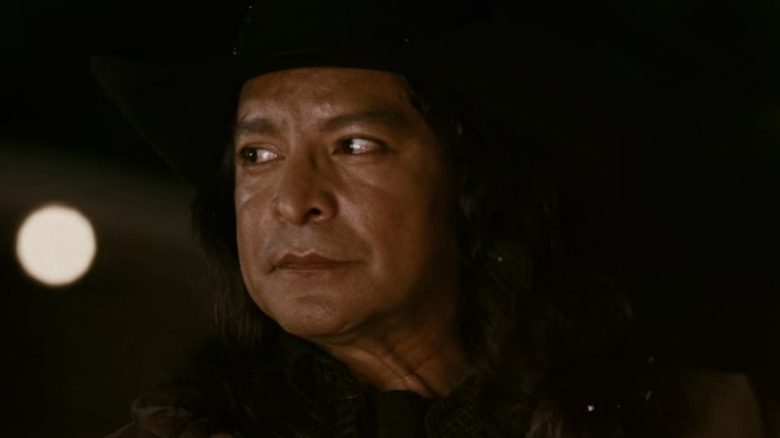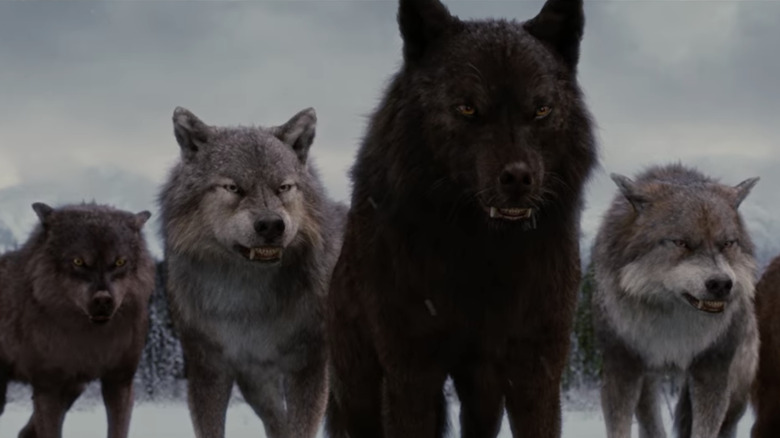Rules Werewolves Have To Follow In Every Twilight Movie
The entirety of the "Twilight" saga is on Netflix, and all we can say is — it's about time. The controversial yet undeniably entertaining series follows the romance of the human Bella Swan (Kristen Stewart) and her vampire paramour Edward Cullen (Robert Pattinson). The two not only have to deal with Bella's mortality and general small-town drama, they also have plenty of powerful foes, including the intimidating Volturi coven and the vampire's natural enemy, werewolves.
Jacob Black (Taylor Lautner), arguably the most famous "Twilight" werewolf, makes up the third corner of the supernatural love triangle at the heart of the franchise. He and Edward vie for Bella's attention until a very questionable plot twist in the series' last installment, but he remains a fan-favorite to this day.
Not unlike the vampires who have certain rules they must follow, Jacob and his pack also have guidelines that both limit them and give them special abilities. Here are the main rules that the werewolves in the "Twilight" series have to follow.
Twilight werewolves are not like regular werewolves
First and foremost, the werewolves in "Twilight" aren't technically werewolves at all — rather, they're shape-shifters whose powers have been passed down through generations. According to "Twilight" lore, the original pack members could leave their bodies and communicate with animals, though the abilities of the Quileute tribe shape-shifters changed drastically over time.
The wolves in "Twilight" also have interesting physical characteristics. For example, once the pack members reach the point where they are able to phase into wolf-form, they typically keep their hair cut short. If they don't, their wolf fur will be long and shaggy like their hair in their human form.
One of the biggest controversies of the "Twilight" saga is the cultural appropriation and general misinformation portrayed about the Quileute tribe, who do exist in real life. The Burke Museum explains the misconceptions that "Twilight" has given to fans about the Quileute people, such as the origin story of the Quileute tribe and the fact that the actual Quileutes definitely don't turn into wolves. Though the "Twilight" author Stephenie Meyer took some creative liberties with her rendition of the Quileute tribe, it's important to note that there are real people out there who have existed for generations who haven't benefited from their portrayal.
Twilight's wolf pack has rules of its own
Much like wolves out in nature, the werewolves in "Twilight" conform to a social hierarchy. Each pack has an Alpha — a leader — who the rest of the pack members have to follow. There are even instances where the Alpha is able to force the other wolves to follow their orders, even if the lesser-ranked wolves resist. The Beta is the second in command in a pack and while they can control wolves lower in the hierarchy, they can't order the Alpha around. Furthermore, Alphas are chosen based on lineage, much like royal bloodlines in other cultures.
The members of each wolf pack can also communicate telepathically with one another. This is obviously useful for things like hunting and fighting, but it's also a tool for the pack members to keep tabs on one another. Unfortunately, being able to read each other's minds also means there's little privacy between pack members — which can definitely make for some awkward moments.
Imprinting is a powerful law
Another controversial aspect of the werewolves in "Twilight" is the matter of imprinting. The exact purpose of imprinting is a bit muddled, but it generally serves as a way for shape-shifters in the Quileute tribe to find their soulmates — though it doesn't have to be a romantic soulmate. Jacob explained it in his own words, saying, "It's not like love at first sight, really. It's more like... gravity moves. When you see her, suddenly it's not the earth holding you here anymore. She does. And nothing matters more than her."
When a werewolf imprints, they become extremely protective of the imprinted-upon person, and will do anything to make them happy, whether that be romantically or in a sibling way. Though Jacob imprints on Bella and Edward's infant daughter Renesmee, he's adamant that it's in a brotherly or even paternal way, and he acts as a sort of bodyguard for Renesmee throughout the rest of the series.
Another important rule of imprinting is that once a werewolf imprints, the other pack members can't harm the imprintee, no matter what. This comes in handy since the climax of the werewolf-vampire battle is due to Renesmee's birth. However, once Jacob imprints on her, the fighting stops immediately.



